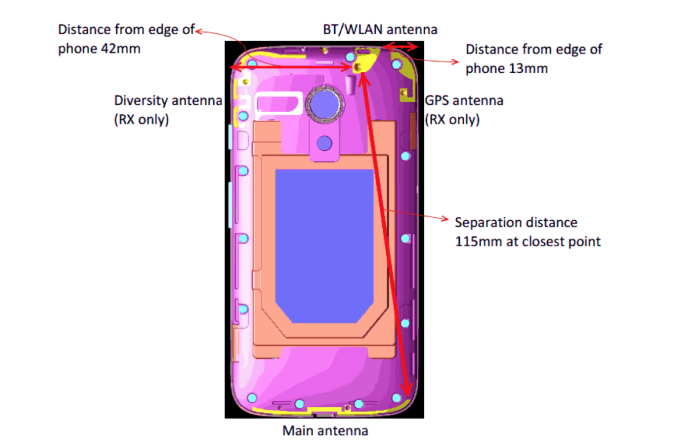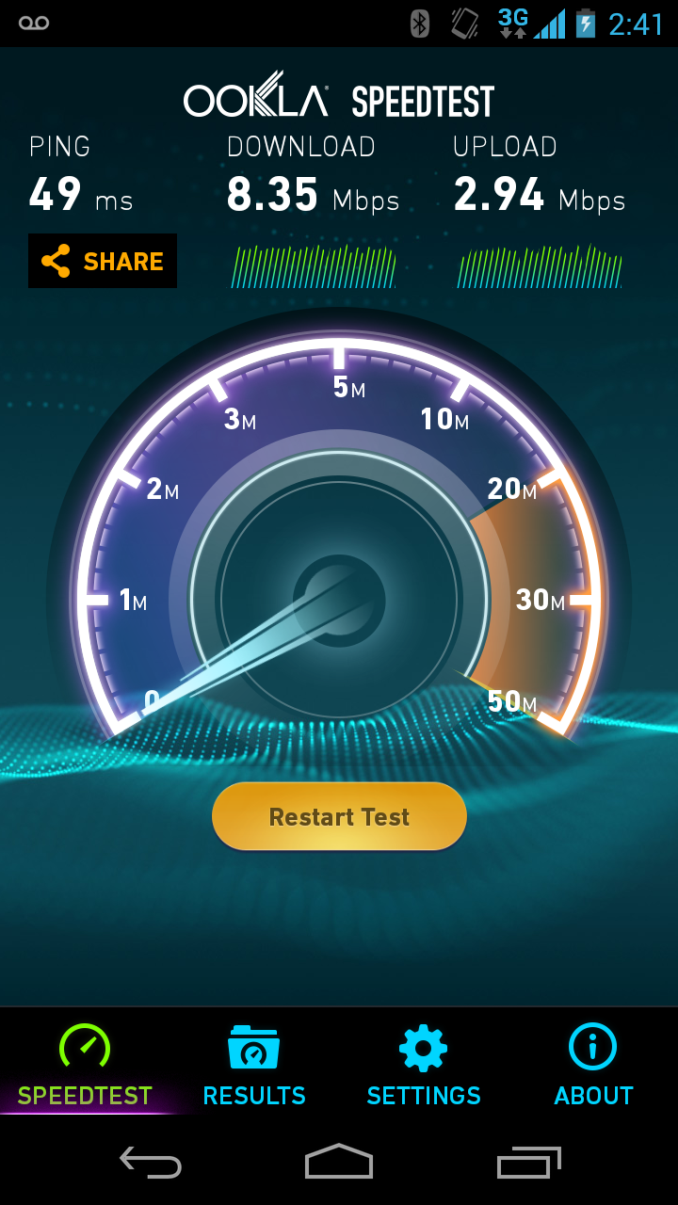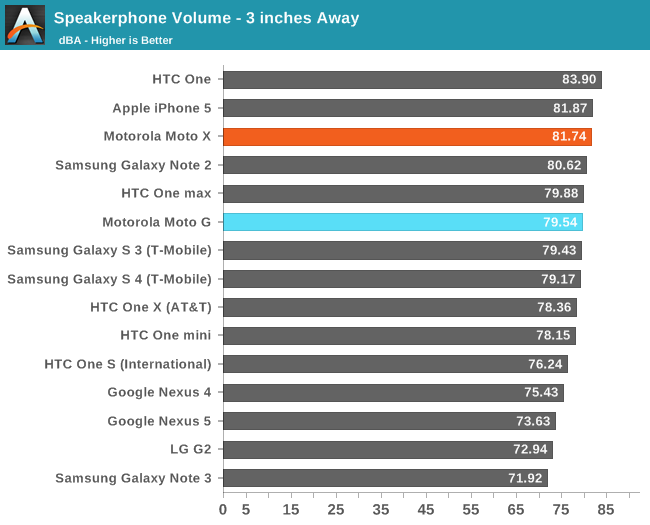Motorola Moto G Review
by Brian Klug on December 18, 2013 2:00 PM EST- Posted in
- Smartphones
- Motorola
- Mobile
- *VA
- Cortex A7
- snapdragon 400
- Moto G
Cellular
The cellular side of the Moto G is an interesting one, at least for those who have kept constantly abreast of wireless banding configurations and the state of mobile RF. At the high end, pentaband WCDMA is now essentially ubiquitous, with parity LTE banding (given the shared nature of ports on the transceiver) and at least a handful more bands for whatever’s appropriate to the region. There’s no global LTE band combination equivalent to quad band GSM or pentaband WCDMA that has emerged quite yet, but it’s getting there, and in the next generation or two we’ll undoubtedly finally see it come to fruition.
|
Moto G (US GSM) |
Moto G (Global GSM) |
Moto G (CDMA) |
|
| Baseband | MSM8x26 - (Up to HSDPA 21.1 Enabled, EVDO Rev.A for CDMA) | ||
| Transceiver | WTR2605/WFR2600 (?) | ||
| GSM | 850/900/1800/1900 MHz | - | |
| CDMA2000 | BC: 0/1/10 | - | 850, 1900 MHz |
| WCDMA |
850, 1700/2100 (AWS), 1900 MHz (Bands 2, 4, 5) |
850, 900, 1900, 2100 MHz (Bands 1,2,5,8) |
- |
| LTE | - | - | - |
The Moto G however comes in a number of different flavors with different band combinations – there’s US GSM, Global GSM, and CDMA. I also suspect there’s at least one more dual SIM variant that we haven’t seen crop up just yet (Update: Apparently this exists already, XT1033 is the dual SIM variant, thanks @evefavretto). On the back case of Moto G there’s a space whose shape matches the microSIM tray at top, and on the board there’s a shield covering pads that are undoubtedly for a microSIM. Interestingly enough Motorola sampled me the Global GSM variant of the Moto G which lacks Band 4. I’ve been using it on T-Mobile successfully however thanks to the relative ubiquity of the 1900 MHz WCDMA carrier in my market. The US GSM variant of the Moto G trades Band 4 for 1 and 8 (2100 and 900 MHz), two popular bands internationally. I’ve seen Moto G erroneously listed as being a pentaband WCDMA phone, which it unfortunately isn’t.

Primary Rx/Tx at bottom, Diversity Rx up top, WLAN/BT, GNSS Rx
Moto G does offer a leg up with receive diversity for CDMA1x/EVDO and HSPA+, something that some HSPA+ flagships from this generation amazingly enough still don’t include. The transceiver is WTR2605 for the primary Rx and Tx ports, and WFR2600 for the additional Rx diversity path. I have no idea what the port configurations look like for WTR2605, but I’d imagine it looks like a cut down WTR1605 of some kind. I have a suspicion that WTR2605 was designed for a quad band UMTS configuration with Bands 1,2,5, and 8, so it might indeed already be port limited in the Global GSM Moto G variant. I also wouldn’t be surprised if there’s some ready made front end module at the front of the whole thing.
Moto G arrives without LTE and instead offers up to single carrier HSPA+ with 64QAM, for up to 21 Mbps on the downlink. Although MSM8x26 itself has a modem block capable of up to dual carrier HSPA+ and category 4 LTE, it seems as though Motorola went for single carrier HSPA+ in the Moto G for time to market reasons, with the LTE and dual-carrier HSPA+ enabled software tree likely slotting in a quarter later than the initial code drop with single carrier HSPA+.


Not bad for single carrier HSPA+ on T-Mobile USA
I’ve been pretty pleased with the cellular performance of the Moto G, even using the variant that lacks Band 4 on T-Mobile USA. Not having LTE made me initially skeptical of it getting operator traction in the US, but it seems as though Motorola has actually had success at least on some prepaid tiers. I’ve been spoiled with LTE devices for a long time now, but single carrier HSPA+ is absolutely still survivable.
WLAN
WiFi connectivity on Moto G is single band 2.4 GHz 802.11n with BT 4.0 and FM receive. On the Moto G, that connectivity is courtesy the new WCN3620 BT/FM/WLAN RF combo chip in a wafer scale package. We’ve now seen WCN3660, the initial dual band combo, then WCN3680 which added 802.11ac, and now WCN3620, the cost reduced version which is single band 802.11n and no doubt offered at a competitive price point with the rest of the platform.
The WLAN/BT stack doesn’t do any antenna sharing and instead has its own transmit and receive path on the top of the Moto G. I don’t have any complaints about WLAN range on the Moto G.
To evaluate performance we turn to the same iPerf test same as always. I was able to attach the Moto G to my network at the 65 Mbps PHY rate that corresponds to long guard interval with a 20 MHz channel.

Performance is pretty decent at just over 50 Mbps. It’s a significant delta over the latest devices with dual band 80 MHz 802.11ac support, but again, totally solid relative to the tier it’s in.
Speakerphone and Noise Canceling
Speakerphone on the Moto G seems to be a big chamber if you take the back off, but there’s a relatively small seal against the whole affair, although the grille has larger holes than Moto X’s relatively tiny ones. Loudness is competitive, but unsurprisingly short of Moto X.

I’d describe Moto G’s speaker as decent, not overly loud or rich sounding.
Dual microphone noise suppression is still a somewhat notable feature at the midrange. In the case of Moto G, Qualcomm’s Fluence package is used in a configuration with the primary microphone at bottom and secondary at very top. I did some digging and also found that Moto G is using Qualcomm’s WCD9302 audio codec which we haven’t seen before, again a more midrange variant. I’ll leave the earphone/line out audio testing for Chris to evaluate.
Noise suppression on the Moto G is decent, but seems to have longer adaptation time than the Moto X. Using the exact same setup, I definitely noticed better rejection on Moto X as well, with less noise being passed through at the same volume level. I should also note that the Moto G does not appear to be AMR-WB enabled on T-Mobile.
GNSS
GNSS onboard the Moto G is the same Gen 8B as we’ve seen on 8974, which translates to support for GPS (USA “Navstar”), GLONASS (Russia), and Beidou (China), although the spec table for Moto G only lists GPS and GLONASS, leading me to believe Beidou might be reserved for devices destined for China. There’s a discrete antenna for GNSS on the Moto G, and I had no issues with getting fast, accurate 3D fixes. I remain impressed with Qualcomm’s GNSS which obviously benefits from integration right into the SoC.










120 Comments
View All Comments
apertotes - Thursday, December 19, 2013 - link
No, I do not. There are two sides here. Some say Samsung sells because of marketing, some say Samsung sells because they understand better what the consumer wants (micro-sd, removable batteries, etc.). Neither side is backing their arguments with any proof at all.uhuznaa - Thursday, December 19, 2013 - link
Well, the fact remains that you can hardly view any review of a competing product on Youtube without a Samsung ad being forced down your throat before it. They must be spending a hell of a pile of money on that.apertotes - Thursday, December 19, 2013 - link
So? Is it less of a fact that Samsung high end devices keep a micro-sd slot and removable battery?Bob Todd - Friday, December 20, 2013 - link
Yes it is, for the simple undeniable truth that enthusiasts make up a tiny sliver of this market (just like is true for most markets). We (enthusiasts) are closer to a rounding error on their financial statements than an overwhelming majority. For every user who clamors for removable batteries or the ability to flash a custom kernel to overclock their phone, there are 95 others who just walk into the store and buy whatever cool phone they saw on TV, or whatever their friends use, or whatever the guy at the counter steered them toward. Samsung could bring the Galaxy S5 to market with sealed batteries and no expandable storage and it would still be the single best selling Android phone by an enormous margin. I have no idea why you are so hell-bent on convincing others, or deluding yourself, that the % of people that really care about these things (or read blogs like Anandtech clamoring for in-depth SOC analysis) make up more than a puddle vs. the ocean of people who DGAF.metayoshi - Friday, December 20, 2013 - link
The guy behind the counter is definitely a major factor, and I believe Samsung dedicates some of their money into that. I remember my sister was due for an upgrade from her Verzion Galaxy Nexus, and I convinced her to buy a G2 and even linked her the mini review from this site. She told me battery life and a good camera were priority, and to me, it was a no brainer.In she walks into the Verizon store, and boy was the guy trying hard to sell the GS4. I told her, the LG has essentially the same features as the GS4 down to the gimmicky camera features, but the camera quality (OIS), and the 3000 mAh battery is much better than what the GS4 will deliver. If I wasn't there, there is no doubt in my mind that my sister would have a GS4.
So yeah... for the people that just don't know what all of their options are, and they go to the phone salesmen for the "expert" advice, which makes up the majority of people, what they're really getting is the phone that the employees are getting paid the most money to sell, which, in my case, was definitely the GS4. After that experience, there is no doubt in my mind that Samsung is giving extra commission to employees who sell these Samsung phones.
shaduck007 - Saturday, January 4, 2014 - link
At Best Buy, I always ask the Intel specialist his opinion.apertotes - Monday, December 23, 2013 - link
That is simply not a fact. That is your poorly reasoned opinion. Facts are:1. Samsung invests a lot of money in advertising and marketing.
2. Samsung's phones have micro-sd and removable battery.
Unless you work as a high level Samsung employee, there is no way to know which of those facts affect sales in a more powerful way.
bhima - Monday, December 23, 2013 - link
iPhones have literally ZERO of those features listed in number 2. They sell by the truckload. Bob Todd is spot on and said it best, Anandtech readers/tech enthusiasts make up a rounding error in the financial statements of these companies.apertotes - Tuesday, December 24, 2013 - link
and that is why HTC did not sell that much. They can't compete on features with Samsung, they are competing with iPhones. And nobody can beat Apple in their own turf. At least Motorola is pricing the G way below.Now, Apple says a truckload of iphones without removable storage or batteries. That is completely true. But Apple is on a league of its own. Neither better nor worse. Simple different. Apple users do not care that much about raw power or features. Also, Starbucks, trendy, hipster, instagram.
boeush - Wednesday, December 18, 2013 - link
"3-4 GB of music" is about 1000 songs."In crappy 64 kbps bit rate, maybe. Personally, I don't do crappy when it comes to my music: all my stuff is ripped to CD-quality at a minimum, and lossless (FLAC) when possible. For instance a single anthology collection for a single band that I have currently on my phone, takes up nearly 10 GiB.